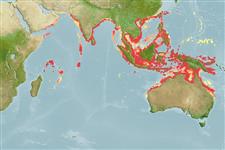>
Gobiiformes (Gobies) >
Gobiidae (Gobies) > Gobiinae
Etymology: Acentrogobius: Greek, a = without + Greek, kentron = sting + Latin gobius = gudgeon (Ref. 45335).
More on author: Valenciennes.
Environment: milieu / climate zone / depth range / distribution range
Ecologia
marinhas; Água doce; estuarina demersal; anfídromo (Ref. 46888). Tropical; 26°N - 27°S, 51°E - 135°W
Indo-West Pacific. Freshwater records from Madagascar by Pellegrin were based on juveniles of unidentified species (Ref. 4343).
Tamanho / Peso / Idade
Maturity: Lm ? range ? - ? cm
Max length : 18.3 cm TL macho/indeterminado; (Ref. 122101); peso máx. Publicado: 51.60 g (Ref. 122101)
Descrição breve
Chaves de identificação | Morfologia | Morfometria
Espinhos dorsais (total) : 6 - 7; Raios dorsais moles (total) : 9 - 10; Espinhos anais: 1; Raios anais moles: 9. Characterized by pale grey body with five diffuse brown saddles along back; midside with 4-5 diffuse brown blotches; head and body with scattered white spots; presence of diagnostic greenish patch behind upper edge of operculum; rounded caudal fin; longitudinal scale series 25-26; scales absent on head except upper half of opercle and predorsal fully scaled; mainly ctenoid body scales; depth of body 5.3 in SL (Ref. 90102).
Occur along coastlines and in estuaries and harbors. Usually found in brackish tidal waters. Feed on invertebrates. Found to contain tetrodotoxin (TTX) and anhydrotetrodotoxin (anh-TTX) which causes paralytic food poisoning (Ref. 54777). Marketed fresh in Mekong delta (Ref. 12693).
Life cycle and mating behavior
Maturidade | Reprodução | Desova | Ovos | Fecundidade | Larvas
Maugé, L.A., 1986. Gobiidae. p. 358-388. In J. Daget, J.-P. Gosse and D.F.E. Thys van den Audenaerde (eds.) Check-list of the freshwater fishes of Africa (CLOFFA). ISNB, Brussels; MRAC, Tervuren; and ORSTOM, Paris. Vol. 2. (Ref. 4343)
Categoria na Lista Vermelha da IUCN (Ref. 130435: Version 2024-1)
Ameaça para o homem
Poisonous to eat (Ref. 54777)
Utilização humana
Ferramentas
Relatórios especiais
Descarregue XML
Fontes da internet
Estimates based on models
Preferred temperature (Ref.
123201): 25.1 - 29, mean 28.2 °C (based on 1000 cells).
Phylogenetic diversity index (Ref.
82804): PD
50 = 0.5000 [Uniqueness, from 0.5 = low to 2.0 = high].
Bayesian length-weight: a=0.00871 (0.00552 - 0.01374), b=3.07 (2.95 - 3.19), in cm total length, based on LWR estimates for this species & Genus-body shape (Ref.
93245).
Nível Trófico (Ref.
69278): 3.5 ±0.37 se; based on food items.
Resiliência (Ref.
120179): Médio, tempo mínimo de duplicação da população 1,4 - 4,4 anos (Preliminary K or Fecundity.).
Fishing Vulnerability (Ref.
59153): Low vulnerability (10 of 100).
